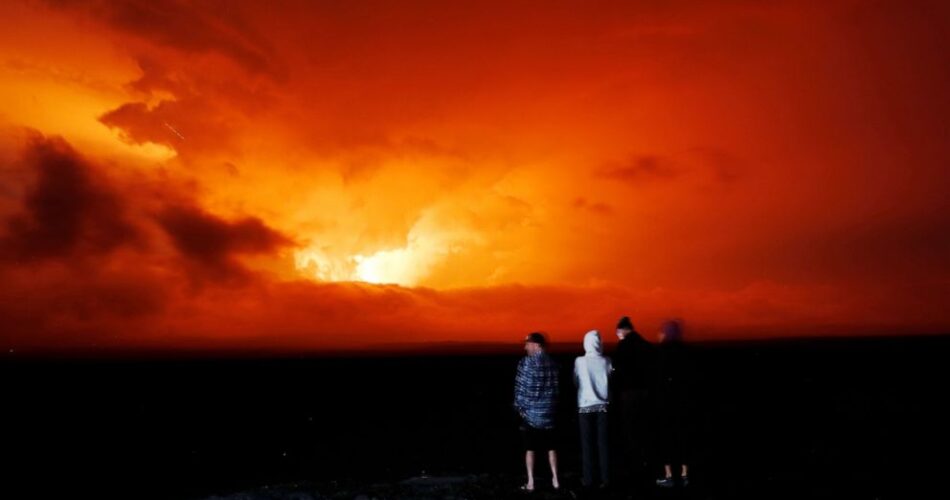HILO, Hawaii — The first eruption in 38 years of the world’s largest active volcano is attracting onlookers to a national park for “spectacular” views of the event, and it’s also dredging up bad memories among some Hawaii residents who have been through harrowing volcanic experiences in the past.
It was just four years ago that Nicole Skilling fled her home near a community where more than 700 residences were destroyed by lava. She relocated to the South Kona area, only to find herself packing her car with food and supplies this week after Mauna Loa erupted late Sunday.
Officials were initially concerned that lava flowing down the side of the volcano would head toward South Kona, but scientists later assured the public that the eruption migrated to a rift zone on Mauna Loa’s northeast flank and wasn’t threatening any communities.
Still, the uncertainty is somewhat unnerving.
“It just happened last night, so I really haven’t had a lot of time to worry about it yet, basically,” Skilling said Monday. “And thankfully, right now, it’s at the northeast rift zone. But if it breaks on the west side, that’s when we’re talking about coming into a large populated area. … That’s why I do have a little bit of PTSD.”
Even though there were no evacuation orders, some people decided to leave their homes, prompting officials to open shelters in the Kona and Kau areas. Very few if any stayed in them overnight, Hawaii County Mayor Mitch Roth said, and they would be closing Tuesday.
“Clearly the danger for the Kau area and Kona area has gone, so there’s really no need to have the shelter up there any longer,” Roth said.
Despite that, some in the area were preparing for unpredictable changes.
Kamakani Rivera-Kekololio, who lives in the south Kona community of Hookena, was keeping supplies like food and blankets in his car.
“We’re being makaukau for anything,” Rivera-Kekololio said, using the Hawaiian word for “ready.”
Ken Hon, scientist-in-charge at the Hawaiian Volcano Observatory, said Tuesday that the lava was flowing “not super fast” at less than 1 mph. It was moving downhill about 6 miles (10 kilometers) from Saddle Road, which connects the east and west sides of the island. The flow was likely to slow down about 4 miles (6.4 kilometers) from the road when it hits flatter ground.
The smell of volcanic gases and sulfur was thick in the air Tuesday along Saddle Road, where people were watching a wide stream of lava creep closer. Clouds cleared to reveal a large plume of gas and ash rising from an open summit vent above the flow.
Gov. David Ige issued an emergency proclamation.
“We’re thankful the lava flow is not affecting residential areas at this time, allowing schools and businesses to remain open,” he said in a statement. “I’m issuing this Emergency Proclamation now to allow responders to respond quickly or limit access, if necessary, as the eruption continues.”
Hon said lava crossed the Mauna Loa Observatory access road Monday night and cut off power to the facility. It could move toward the county seat of Hilo, he added, but that could take a week or longer.
Meanwhile, scientists are trying to measure the gas emitted from the eruption.
“It’s just very early in this eruption right now,” Hon said.
The eruption is drawing visitors to Hawaii Volcanoes National Park, which is open 24 hours a day. “The viewing has been spectacular” especially before sunrise and at night, park spokeswoman Jessica Ferracane said.
Visitors there are currently able to witness two eruptive events: the glow from Kilauea’s lava lake and lava from a Mauna Loa fissure.
“This is a rare time where we have two eruptions happening simultaneously,” Ferracane said.
Hilo resident Lea Ferreira said she doesn’t plan to be one of those spectators. And she’s not worried about this eruption because she remembers the last one in 1984.
“This is nothing. She came out quiet, very quiet,” she said, referring to Pele, the Hawaiian deity of volcanoes and fire. “In 1984, you could see the flow high in the air.”
Ferreira said she could see only a bit of the glow and a “very small amount of lava” from Hilo.
Some people were driving to get a closer look, but Ferreira won’t: “I’ll let her do her thing.”
———
Kelleher reported from Honolulu. Audrey McAvoy in Honolulu contributed.
Source link




